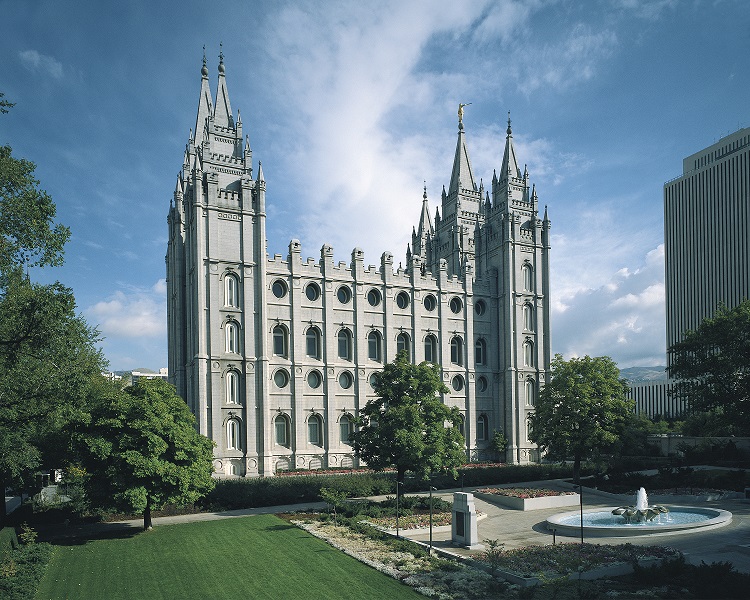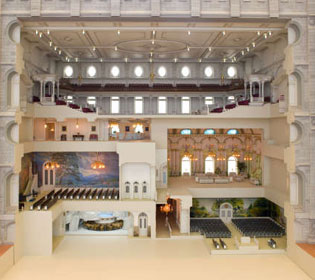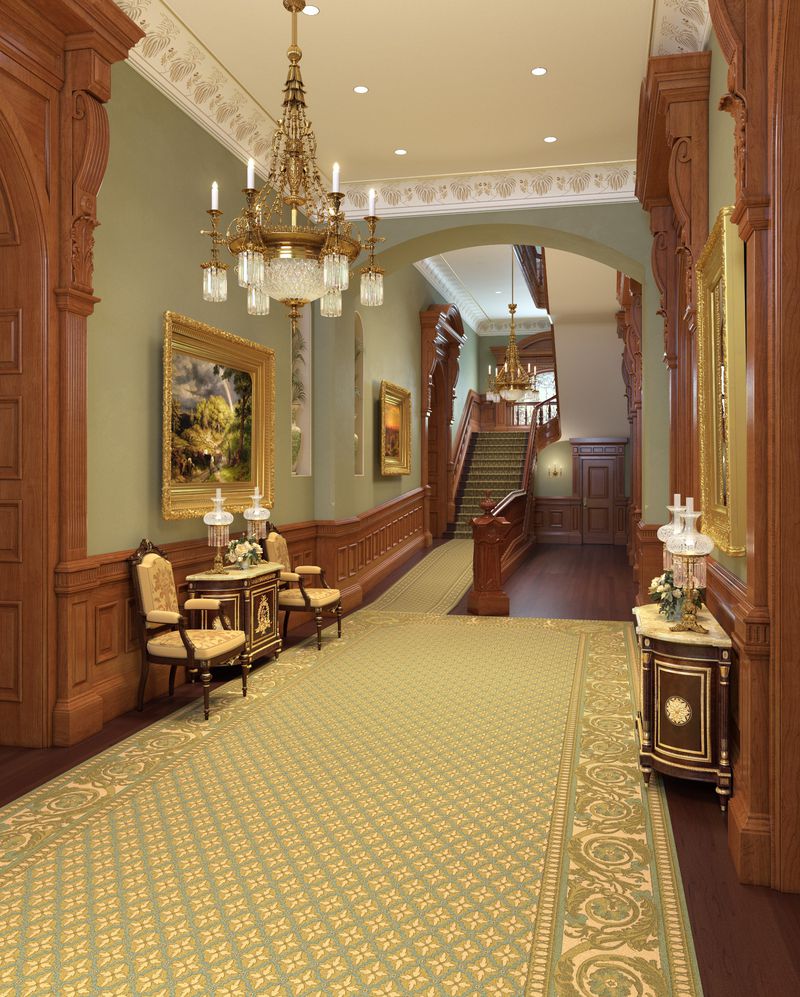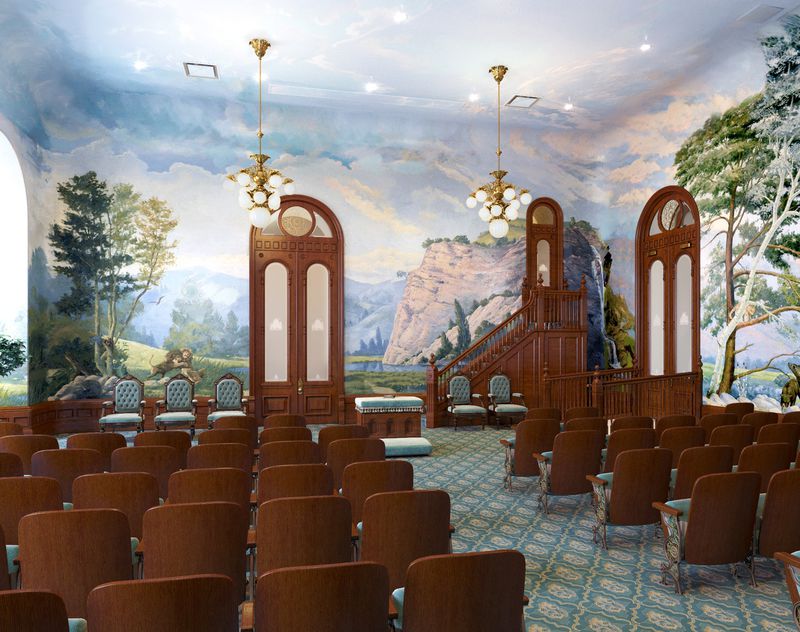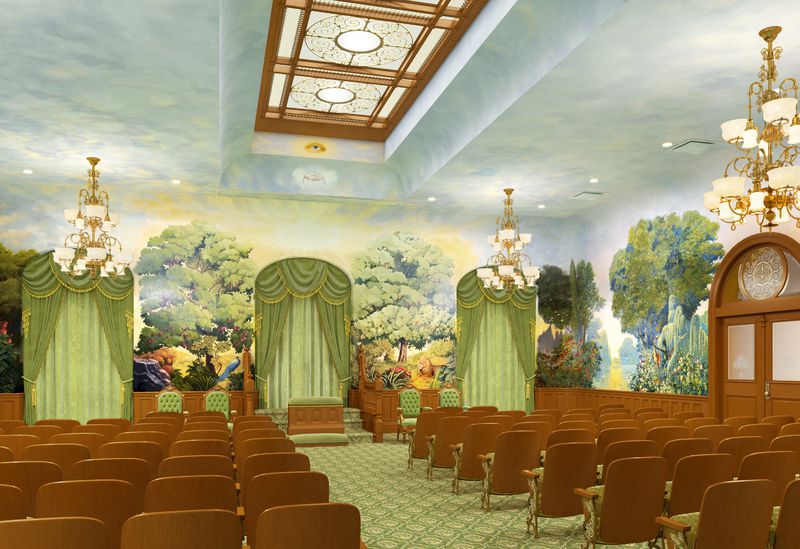Salt Lake Temple
The Salt Lake Temple was the sixth temple completed by The Church of Jesus Christ of Latter-day Saints and the fourth finished after the Mormon pioneers' arrival in what is now the State of Utah. Its construction took 40 years, and it stands as a striking emblem of the Latter-day Saints' dedication and perseverance. It is also the most well-known temple and has come to symbolize the Church to many throughout the world.
In late July of 1847, the first group of Latter-day Saint pioneers entered the Salt Lake Valley. Within a few days, their leader Brigham Young indicated the precise location where the holy edifice should stand by striking the ground with his cane and announcing, "Here we will build a temple to our God." Apostle Wilford Woodruff marked the spot then and there. Construction of the temple began on 14 February 1853, following a groundbreaking ceremony conducted by Brigham Young.
A granite deposit was found nearby, and workers began to hand-chisel massive granite blocks which weighed between 2,500 and 5,600 pounds. These large stones were transported by ox-drawn wagon (and later railroad) to the temple lot. Most of the labor was performed by volunteers who, despite their hardships in trying to settle a new land, gave freely of their time and skills. Brigham Young encouraged the Saints to make the Salt Lake Temple the best it could be. The prophet stated that he wanted "to see the Temple built in a manner that it will endure through the Millennium" (Journal of Discourses, 10:254). The temple was built accordingly. Brigham Young also worked extensively with architect Truman O. Angell, directing what the temple was to look like according to the visions and revelations that were given to him by the Lord. The architectural style of the temple is often described as Gothic, complementing the doctrinal symbolism and revelatory layout of the temple.
There were numerous challenges that slowed the construction of the temple. At one point Church leaders learned that a U.S. Army contingent was being sent to Utah. Latter-day Saints distrusted the government that had allowed them to be persecuted and pushed out of Illinois, Missouri, Ohio, and New York, so the work on the temple was stopped and the entire foundation was buried. As positive relations developed between the U.S. Government and the Church, work on the temple was resumed. The foundation was uncovered, but workers found that there were cracks in the foundation blocks. They were forced to take them out and start over, using new stones that were cut to fit together without mortar.
The Saints worked tirelessly to build the 253,015 square-foot temple. Once the exterior was completed, skilled artists and craftsmen were brought in to complete the temple's 170 rooms. The interior furnishings were completed in one year, marking 40 years since the groundbreaking ceremony. During the years of the Salt Lake Temple's construction, three other pioneer temples were completed: The St. George Utah Temple (in 1877), the Logan Utah Temple (in 1884), and the Manti Utah Temple (in 1888). The Salt Lake Temple, dedicated in 1893, became the largest temple, with twelve sealing rooms and four ordinance rooms (after various additions and remodeling). With well over a hundred temples constructed since then, it still remains the largest in the Church.
The Salt Lake Temple is also unique in that the President of the Church presided directly over a temple. Elder David B. Haight related why he felt this temple received such special attention:
- "The work of this great temple was so significant to these men that they were willing to carry the additional responsibility of presiding over it and looking after its operation—in essence going to the temple each morning and taking care of business there before going to do the work of the First Presidency of the Church ("Symbol of Sacrifice, Monument to Life," Ensign, Oct. 1993, 9).
Unfortunately, Brigham Young did not live to see the completion of the Salt Lake Temple; nor did his successor, John Taylor. The temple was finally finished under the direction of Wilford Woodruff, then the fourth president of the Church of Jesus Christ. Dedicatory services took place on 6 April 1893. Many other dedicatory services followed, providing "opportunity for eighty-two thousand people to participate in presenting their temple to their God" (Wallace Alan Raynor, The Everlasting Spires: The Story of the Salt Lake Temple, Salt Lake City: Deseret Book Co., 1965, p. 159).
J. Golden Kimball of the First Council of the Seventy said the following about what the Salt Lake Temple meant to him:
- When I think about [the temple], every stone in it is a sermon to me. It tells of suffering, it tells of sacrifice, it preaches—every rock in it, preaches a discourse. When it was dedicated, it seemed to me that it was the greatest sermon that has ever been preached since the Sermon on the Mount.... Every window, every steeple, everything about the Temple speaks of the things of God and gives evidence of the faith of the people who built it (Conference Report, Apr. 1915, p. 79).
Contents
- 1 Scaled Model of Salt Lake Temple Gives Open House Experience
- 2 Historic Salt Lake Temple to be Renovated
- 3 Renderings of What the Salt Lake Temple Renovations Will Look Like
- 4 The Salt Lake Temple is Decommissioned
- 5 First Presidency Announces Changes to the Salt Lake Temple
- 6 First Presidency Announces Updates, New Completion Date for Temple Square Renovations
- 7 External Links
- 8 Videos of the Salt Lake Temple
- 9 Temples in Utah
Scaled Model of Salt Lake Temple Gives Open House Experience
In May of 2010, an 88-inch tall scale model of the Salt Lake Temple was put on display in the South Visitors' Center in Temple Square. The scaled replica is 1:32 and shows the interior rooms of the temple.
- The model of the Salt Lake Temple sits in front of a giant window in the South Visitors' Center facing the actual building that it replicates. The south and east walls of the replica have been cut away to show depictions of many of the rooms in the temple, including the large assembly hall and rooms where the First Presidency and Quorum of the Twelve Apostles meet. The baptistry and other ordinance rooms are also depicted. Close attention is paid to detail, and even paintings, furniture and working chandeliers and lamps imitate those found in the actual temple.
- Peter McCann Architectural Models of Toronto was commissioned to create the replica in August 2009. Sixteen modelers with different expertise in various parts of the duplication process worked on the project for five months.
- "This replica will show the millions of visitors who come to Temple Square the beauty and majesty of this sacred and historic building," said Elder Richard G. Hinckley, executive director of the Missionary Department. "Like all temples, once the building is dedicated it is used for sacred Church purposes and not open to the general public, but this exhibit will provide the public with a glimpse of the interior and a feeling of the Spirit that is present there."
- The Salt Lake Temple is a landmark known throughout the world. When it was last open to the public in April of 1893, the local press reported that approximately 5,000 people, most of whom were not members of the Church, toured the temple before the dedication. The reports went on to say that "altogether the richness and elegant workmanship of the temple was a revelation of wonder to the visitors."
- "Many people think our temples are like great halls or cathedrals. Actually, they have a number of rooms designed for certain functions such as marriages, baptisms, and instructional sessions," said Elder William R. Walker, executive director of the Church’s Temple Department.
- In addition to the scaled model, the new display in the South Visitors' Center features new kiosks that show high-definition photos and video of the Salt Lake Temple interior rooms. A narrator gives an explanation of the purpose of the rooms and a diagram shows where they are located on the model. The presentation is very similar to what a person would experience during the public open house of a temple. [1]
- To see a video describing the scale model and display, click here.
See also Temple Square
Historic Salt Lake Temple to be Renovated
Details and project renderings have been released regarding the upcoming closure and renovation of the historic Salt Lake Temple of The Church of Jesus Christ of Latter-day Saints.
During a morning press conference held on Friday, 19 April 2019, Russell M. Nelson, President of the Church, announced the pioneer-era temple will close 29 December 2019 and will remain closed for approximately four years while undergoing a major structural and seismic renovation. The temple is expected to reopen in 2024 with a public open house.
Bishop Dean M. Davies, then first counselor in the Presiding Bishopric, commented, "This will be an incredible opportunity. For generations, only faithful members have been able to enter the Salt Lake Temple. Now everyone — people of our faith, other faiths or no faith — will be able to come to the temple." He added that open-house visitors will see more than beautiful architecture and interior design. He said, "They will also feel the 'sense of the sacred' in the temple. I can’t think of a more wonderful opportunity. It may take more than two months to get everyone through. . . .We want everyone to know they are welcome. We want them to come and see and feel why this temple is so beautiful to us. We want it to be their temple too. The temple is part of the community."
The surrounding area on Temple Square and the plaza near the Church Office Building will also be affected as existing buildings are demolished and the area undergoes renovation and restoration. The existing annex and temple addition on the north side, which was built in the 1960s to add needed support facilities and more sealing (marriage) rooms, will be demolished and rebuilt.
Brent Roberts, managing director of the Church’s Special Projects Department, said, "This upgrade will include a base isolation system, which is one of the most effective means of protecting a structure against earthquake forces. This unique system will preserve the historic footing of the temple. Once complete, it will help protect people, the historic building, and the beautiful interior finishes in the event of an earthquake."
It is expected that the Tabernacle and Assembly Hall will remain open to the public during construction, and tours by missionaries from the Temple Square Mission will continue to be available for guests. Other Temple Square attractions that will be accessible to visitors during the temple renovation include the Family History Library, Church History Museum, Church History Library, Conference Center, Joseph Smith Memorial Building, Lion House, and Beehive House.
During his remarks at the press conference, President Nelson said, "This project will enhance, refresh, and beautify the temple and its surrounding grounds. Obsolete systems within the building will be replaced. Safety and seismic concerns will be addressed. Accessibility will be enhanced so that members with limited mobility can be better accommodated." He added, "We promise that you will love the results. They will emphasize and highlight the life, ministry, and mission of Jesus Christ in His desire to bless every nation, kindred, tongue, and people."
Renderings of What the Salt Lake Temple Renovations Will Look Like
On Wednesday, 4 December 2019, The Church of Jesus Christ of Latter-day Saints released four new renderings of what the temple renovation will look like when it’s done in 2024. The pictures in the gallery are taken from Deseret News and are ©2019 by Intellectual Reserve, Inc.
The Salt Lake Temple is Decommissioned
On Sunday, 5 January 2020, the Salt Lake Temple officially closed for extensive renovations. The temple will be closed for the next four years. Within hours of the closure, workers got busy transitioning the sacred structure from a working temple to a construction site. The process, known as decommissioning, takes several weeks. It is an important first step in the years-long project that will restore and refresh the historic temple and help strengthen it against earthquakes.
Rich Sutton, temple area director, said, "Each time we renovate a temple of The Church of Jesus Christ of Latter-day Saints, decommissioning occurs to remove sacred items and turn the building into a construction site. We have been preparing for months for this process, which began almost immediately after the temple closed to patrons on December 29."
Emily Utt, a curator in the Church History Department, added, "The Salt Lake Temple is somewhat unique due to its size and the years of history dating back to 1893. This building has been carefully cared for and preserved for a long time, and it’s a sacred experience to be involved in preparing it for this next important step."
The renovation of the Salt Lake Temple is expected to be completed in 2024, followed by a public open house and rededication. Temple Square remains open during the renovation, with a new visitor experience available at the Conference Center. It is anticipated that the South Visitor’s Center and portions of the Temple Square wall will be demolished in mid-January. For more information on Temple Square please go here.
First Presidency Announces Changes to the Salt Lake Temple
The First Presidency announced on Friday, 12 March 2021, that the Church will discontinue the practice of having ordinance workers make a live presentation of the endowment — a temple ceremony depicting the Creation, Fall, and Atonement of Jesus Christ — at the Salt Lake Temple when its renovation is complete. The endowment ceremony will proceed with films, as is done in every other temple of The Church of Jesus Christ of Latter-day Saints. The decision also means an end to the historic, century-old frescoes painted on the walls of the multiple rooms that have been used for the progressive, room-to-room, live endowment.
The Salt Lake Temple renovation is also being adjusted to include the addition of a second baptistry. Some have speculated about such a move in recent years because of the large numbers of Latter-day Saint youth who want to perform baptisms by proxy for their ancestors.
The First Presidency also noted Friday that the significant seismic and accessibility upgrades combined with the new decision to add two instruction rooms for single-room endowment presentations by film required the removal or repainting of murals painted on the walls of the endowment rooms in 1892-1893 and 1915. It was stated in the press release that it "was impossible to know whether the murals could be preserved during such a move. They were originally painted directly on lath and plaster walls, which had been repaired and repainted many times because of water damage and other deterioration. Further, the change to a film presentation meant that the rooms would be reconfigured. For all these reasons, the murals were carefully photographed and documented before removal, and some of the original portions are being preserved in the church’s archives."
According to the press release on Friday, the Salt Lake Temple’s capacity will more than double with the changes. The two added instruction rooms, additional sealing ordinance rooms, and the second baptistry will expand capacity and the number of temple ordinances performed. While the moves will make way for more endowment sessions, starting more frequently, they also will allow the temple to offer the endowment ceremonies in 80 languages instead of only in English.
The First Presidency also said it had decided to remove the Salt Lake Temple cafeteria. Its space will be used for facilities to support the temple’s increased capacity.
The three members of the First Presidency, President Russell M. Nelson, President Dallin H. Oaks, and President Henry B. Eyring said they look forward to the renovation’s completion, scheduled in 2024, and hosting an open house. They said, "We look forward to the day when the renovation is complete and we can welcome friends from around the world to tour the temple prior to its dedication, and then for members to once again worship in this beautiful house of the Lord."
First Presidency Announces Updates, New Completion Date for Temple Square Renovations
This statement was originally published on Newsroom.
- The seismic strengthening of the Salt Lake Temple and the extensive remodel of the Temple and surrounding area are sacred and significant undertakings. As the project has progressed, we have learned a great deal about the condition of the temple and its surroundings. The work is truly remarkable and is being guided by the First Presidency. Inspired modifications and additions to the project and scope have been made so the temple and Temple Square can serve many generations yet to come. It is anticipated that the temple and its surroundings will be completed in 2025. We look forward to welcoming the world at that time to visit, tour and learn about this sacred temple and The Church of Jesus Christ of Latter-day Saints.
External Links
- Salt Lake, Manti temples to end live presentation of endowment sessions as more changes announced
- Salt Lake Temple Undergoes Decommissioning
- Start of the multi-year renovation of iconic Salt Lake Temple is days away; new interior renderings released
- Salt Lake Temple to close in December — here’s what you need to know
- What will visits to Temple Square be like during temple renovation? We now know
- 'This will be an incredible opportunity': Iconic Salt Lake Temple to hold a public open house in 2024
- FAQ: What you need to know about the church's Salt Lake Temple renovation announcement
- 10 Fascinating Facts You Didn’t Know About the Salt Lake Temple
- Surprising stories, fun facts and other things you might not know about the Salt Lake Temple
- Official Salt Lake Temple page
- Salt Lake Temple page
- Mormon Temples - Lightplanet
- Mormon Temples and Secrecy
- Church News, “Inside Church Headquarters: The location, design and construction of Latter-day Saint temples
- FamilySearch RootsTech, Temple Invitation by Russell M. Nelson
Videos of the Salt Lake Temple
Temples in Utah
- Bountiful Utah Temple
- Brigham City Utah Temple
- Cedar City Utah Temple
- Deseret Peak Utah Temple
- Draper Utah Temple
- Ephraim Utah Temple
- Heber Valley Utah Temple
- Jordan River Utah Temple
- Layton Utah Temple
- Lehi Utah Temple
- Lindon Utah Temple
- Logan Utah Temple
- Manti Utah Temple
- Monticello Utah Temple
- Mount Timpanogos Utah Temple
- Ogden Utah Temple
- Oquirrh Mountain Utah Temple
- Orem Utah Temple
- Payson Utah Temple
- Provo City Center Temple
- Provo Utah Rock Canyon Temple
- Red Cliffs Utah Temple
- Salt Lake Temple
- Saratoga Springs Utah Temple
- Smithfield Utah Temple
- St. George Utah Temple
- Syracuse Utah Temple
- Taylorsville Utah Temple
- Vernal Utah Temple
- West Jordan Utah Temple
